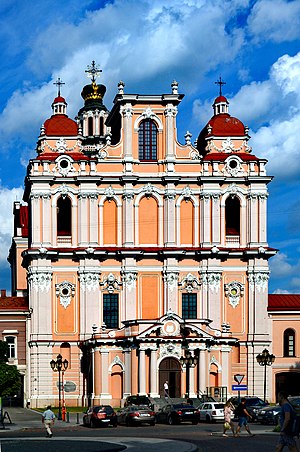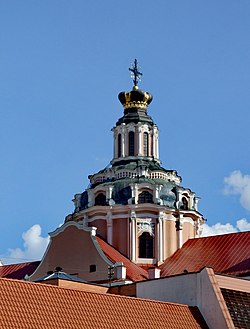St. Casimir (Vilnius)
The Casimir Church ( Lithuanian Švento Kazimiero bažnyčia ) is one of the most important churches in the city of Vilnius . She is the first representative of the Baroque architectural style in the Lithuanian capital, who came to the far north-east of Europe with the Jesuits . The patron saint of the church is St. Casimir , the patron saint of Lithuania.
construction
The construction time of the Casimir Church was 1604-09. The interior was finally completed in 1615. It became the parish church of the Jesuits, who came to Vilnius in 1569 and initially used the St. John's Church , which was next to the university they founded , for their services. Like many Jesuit churches, the Casimir Church was modeled on the first Jesuit church, Il Gesù in Rome . Typical of the early baroque church is the combination of central space and nave architecture with a large, light-giving dome over the crossing (here 40 m high and 17 m in diameter), a wide single-nave nave (here 25 m wide) and the one towards the center increasing sculptural design of the front facade. In contrast to Il Gesù, the front facade of St. Casimir has two towers.
history
The Jesuits were to support the Counter-Reformation in the Lithuanian Grand Duchy from Vilnius . One of its most important representatives from this period in the early 17th century. was St. Andrew Bobola , who was ordained as a priest in the Casimir Church in 1622, after having previously studied at the Jesuit University in Vilnius .
Over the centuries the church suffered a number of devastations: in 1655 when the city was occupied by Russian troops, in 1706 by a fire in connection with the siege by the Swedes, and again by fire in 1749. 1750–55 the church was refurbished in the high baroque style, u. a. with a splendid high altar and the striking gold-plated crown over the crossing. After the Grand Duchy ended in 1795, the crown on the church dome was also destroyed in 1796. The interior was devastated by Napoleon's troops, who set up a storage room here in 1812. After the Jesuit order was banned in 1773, the Augustinians took over the church, later a missionary order, and after the uprising in 1831 the church was converted into the Orthodox Nicholas Church in 1839 as part of the Russification efforts of the Tsarist administration . During this time, it was heavily rebuilt according to a design by the Russian architect Nikolai Tschagin (1864-68): the towers were dismantled and given onion dome helmets , the front facade was also heavily modified and an iconostasis was installed.
After the First World War , Lithuania had been ruled by Russian since the final partition of Poland and had declared its independence from the Russian Empire , the Jesuits took over the leadership of the church again. The Baltic States were first occupied and then annexed by the Soviet Union at the beginning of the Second World War . The invading Wehrmacht drove them out and was welcomed by their inhabitants as their liberators . Jonas Mulokas designed and made the dome crown in 1941, which is now a symbol of independence. When the Red Army returned to Lithuania in 1944, numerous Lithuanians fled from them to avoid alleged persecution . The Soviet authorities of the present Lithuanian SSR closed the church in 1949, destroyed its interior and used it as a storage room for wine and grain. After a renovation in 1955-57, a museum of atheism was opened in the church in 1966. In 1989 the church was returned to the Jesuits and reopened in 1991.
organ
In 2003, the Lithuanian organ builder Laimis Pikutis installed a large three-manual organ with 45 registers and a 16 ' prospect in the gallery of the church , which was made in 1968 by the German organ builder using older parts of a Stumm organ that Heinrich Voit first rebuilt in 1894. The Oberlinger dynasty had been built for the town church Durlach .
crypt
The crypt from the time the first church was built in the 17th century, which was only discovered during the renovation work in 1991, survived all the destruction unscathed . Drawings and lyrics have been preserved on its vaulted walls, which are up to 6 m high.
Web links
Coordinates: 54 ° 40 ′ 39.4 ″ N , 25 ° 17 ′ 18.6 ″ E






